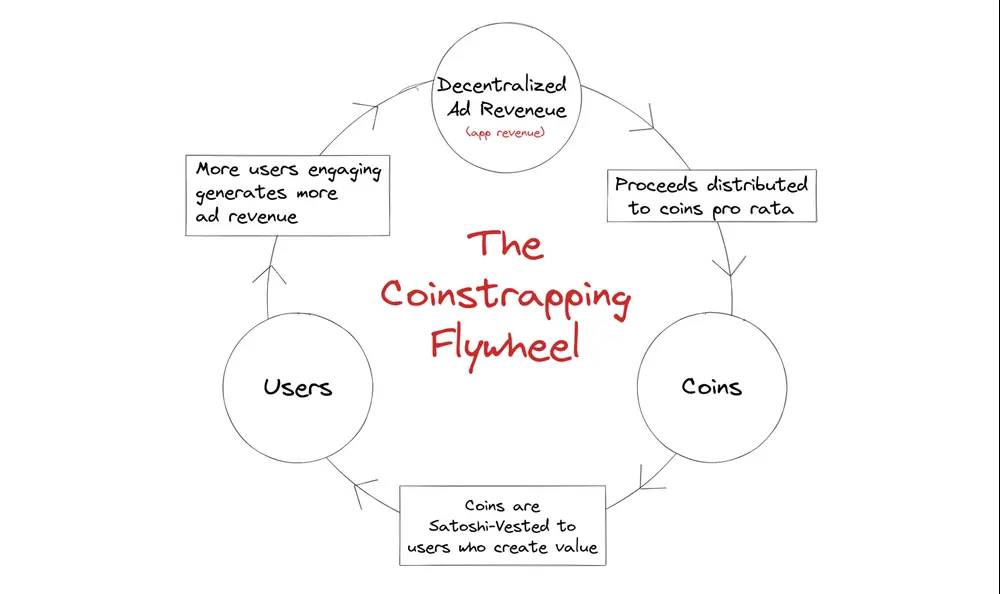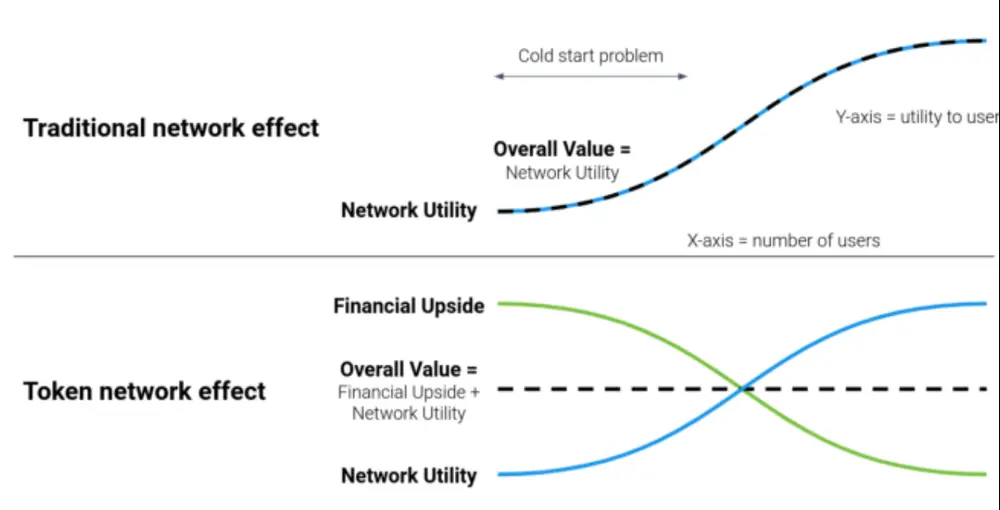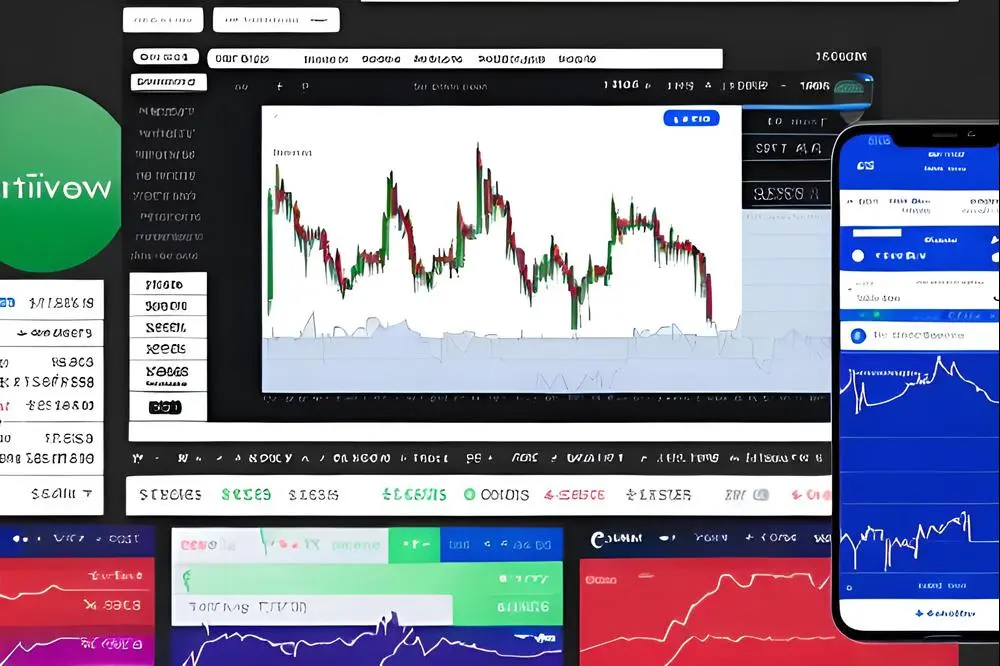Coinstrapping: Building a Sustainable Crypto Flywheel
A crypto-native way to bootstrap an app, with a novel Crypto Reddit concept as an example

What if there was a better way to "launch and iterate" a new product? What if you could know that a product was demanded by the market before starting to work on it?
In this post, I'm going to start by explaining a novel product bootstrapping mechanism I call coinstrapping, and then I'm going to describe how to use coinstrapping to launch a sustainable Crypto Reddit product as an example.
Coinstrapping: From Binance to Uniswap
Imagine you have an idea for a new product that you're really excited about. Now also imagine that you have some way to make money with your product that is coherent. What do you do?
The naive answer would be to launch your product the "old-fashioned" way: put out a minimum viable product, try and get some users, and iterate.
But the crypto answer is often a little more interesting. In particular, if you have a reliable way to make money with your product, you can start by allocating that money to a tradable crypto coin. Why would anyone ever do this? Because in doing so, you create an asset that you can use to finance user acquisition early on— namely by giving that coin away to users who are active on your platform.
Possibly the best example of this was Binance, the largest cryptocurrency exchange in the world. They were much smaller than other exchanges like Coinbase when they launched, but they had a secret weapon: They launched a coin, BNB coin, pledged a percentage of their trading fees to it, and started giving away BNB to people who traded on the exchange.
How'd that work out for them? Well, today Binance is the largest exchange in the world by a full order of magnitude, and BNB is the third most valuable cryptocurrency at a market cap of ~$54 billion...
But that's not all. Some of the most successful DeFi projects in crypto used a coin to bootstrap their projects as well. Compound and Aave are lending platforms that launched with a coin to incentivize providing collateral assets for loans. By giving your collateral to the protocol, you'd earn yield in the form of COMP coins, for example. Similarly, Sushiswap and Uniswap reward users with a coin for providing trading liquidity, and have pledged trading fees back to the coins as well. DeSo itself, where this post is published, launched with a coin, and will similarly burn its transaction fees.
The reason launching a platform with a coin works so well is because the coin can pull forward excitement in the platform, and then this excitement can be used as fuel to subsidize adoption early on, when the platform is small. The following chart from a post by Chris Dixon from a16z illustrates this nicely.

Even though some of the largest exchanges and DeFi projects in the crypto space have all used coins to bootstrap their growth, it's not widely understood (yet) how coins can be leveraged to grow more "web2" style businesses like social networks and gaming platforms.
In essence, we want to take the "magic" powering Binance, Sushiswap, and Compound, and apply it to less financialized applications.
In what follows, I'll introduce a new mechanism for using a coin to bootstrap a product that I'll refer to as coinstrapping. Then, in this post and in future posts, I'm going to highlight a few concrete ideas that are amenable to the coinstrapping approach. All concepts will follow the same basic framework:
- Have an idea for some piece of software that people want
- Define how that software is going to generate income in the future, e.g. via fees
- Pledge those fees to a coin
- Use the coin to incentivize adoption by rewarding early adopters who use the platform with the coin
- Optional: Sell the coin initially to raise funds or allow people to liquidity mine it by staking assets (more on this later)
Crypto Reddit With Decentralized Ads

Now we'll illustrate the coinstrapping approach with a novel Crypto Reddit concept.
Imagine a forum app like Reddit, but everybody gets paid to engage. Creators get paid to post, casual readers get paid when they like posts that are popular, and moderators get paid as well. Let's call this new app simply "Forums."
Reddit’s revenue comes from ads, and Forums can start the same way— but with a crypto twist. Each individual forum, which is like a Subreddit on Reddit, can generate revenue as follows:
- Every week, each forum will automatically auction off an “advertiser NFT.”
- This NFT gives the holder the ability to choose a single post to promote at the top of that particular forum.
- For example, if I own this week’s advertiser NFT for the f/Bitcoin forum, I can select a post promoting my project to sit at the top of that forum for that particular week.
- In the long run, this model can become more sophisticated, allowing for individual user targeting via user-level NFTs. For example, an individual user can auction off the ability to target themselves with ads, and keep the income stream from that. But let's keep things simple for now.
- Clearly, this scheme will generate some revenue for the platform.
- We can also allow users to tip one another and take a fee from that, allow users to mint NFTs and take a fee from that, etc... But let's stick with the forum-level ads to start.
I haven't seen a social network implement a model like this to generate ad revenue, but it seems to have a few key advantages over traditional ads. First off, it's permissionless, meaning that anyone can participate in the auction of the NFT every week, rather than needing some broker between advertisers and the social platform itself. But, perhaps more importantly, all of the auction mechanics can be implemented entirely on-chain, e.g. via DeSo, providing an auditable and perpetual source of proceeds to a coin.
You know where we go from here: We can pledge the entire proceeds of the weekly ad auctions to a coin. Let's say we just distribute the proceeds pro rata to coin-holders every time an advertiser NFT is sold (note that pro rata means in proportion to how many coins they have). In doing this, we have now created an asset that we can use to bootstrap usage on the platform, as we will discuss in the next section.
Side-note: Once our coin becomes liquid and trade-able, we can alternatively use the advertising proceeds to market-buy the coin and burn it, which is what Binance does for BNB— but this isn't necessary initially. Additionally, distributing revenue to coins pro rata gives us an opportunity to notify a large subset of users about how the platform is rewarding them!
Satoshi Vesting: How to Distribute Coins to Users
Now that we have a coin, a natural next question is how do we distribute coins to users to maximize engagement? Continuing with the Forums concept, we want to give users coins in such a way that they are motivated to produce content forever. But we don't want to do this in a way that causes forever inflation in the coins because this would make it hard for someone to value the system.
So what do we do... Luckily, there is a simple solution, which is to "taper" or reduce the number of coins being paid over time in a particular way that results in a capped number of coins. Bitcoin does exactly this: It halves the number of coins that are paid out to miners every four years in order to achieve a long-term fixed supply of 21M coins. This makes sense, especially given that one could reasonably expect the value of a platform to increase over time.
Putting this all together, and paying our respects to Lord Satoshi, we can allocate 100M coins to content creators, namely people who post on the platform, and we can distribute this 100M coins as follows:
- Year 1: distribute 50M coins, Year 2: distribute 25M coins, etc... (this series adds up to 100M coins)
- If you post on a particular day, you get a pro rata share of all the coins distributed for that day.
- This means that, initially, users will be getting a lot of coins, similar to how early Bitcoin miners got a lot of Bitcoin, creating a strong incentive to be active ASAP.
To compute the market cap of the coin, then, you just have to multiply the price of a single coin by 100 million. Simple and clean!
Of course we can also allocate coins to other constituents. For example, we could allocate another 10M to moderators, 100M to casual users who like posts on the platform, etc... But in all cases, Satoshi Vesting can be used to ensure a perpetual incentive for whatever we're trying to get users to do.
Targeted Airdropping: The Growth Hack
In addition to giving users vested coins for posting, engaging, moderating, etc... one can define a one-time reward for joining the platform targeted at a particularly valuable set of users on another platform.
For example, if you're coinstrapping a Crypto Reddit, it's safe to say that someone who already has a Reddit account is likely more valuable as a user than someone who doesn't. And so you can use your coin warchest to offer an existing Reddit user an added incentive as follows:
- Every user on Reddit can get some number of coins for free if they do the following:
- Create an account on the new platform.
- This can alternatively be described as "claiming" one's account, which users of BitClout will be familiar with. For example, every user of Reddit can have a "ghost profile" pre-created for them on the new platform showing them explicitly how much they stand to gain by joining or "claiming" that profile. This doesn't really change anything about the mechanism, except for the fact that it makes things more share-able. In particular, someone can send you your ghost profile and communicate to you the incentive of joining a bit more easily.
- Make a post on Reddit that you've claimed your account on the new platform.
- This incentive can be increased if the person is a mod posting in a Subreddit they control, for example, among other tweaks.
- Create an account on the new platform.
This kind of growth hack is sometimes referred to as a vampire attack, and one can study examples by considering LooksRare or SushiSwap. But I prefer to refer to it as simply an airdrop of coins, which is a bit less hostile.
Using a Fundraise to Test Demand
Suppose you're excited about the Forums idea, but you're not 100% sure if other people will be excited about it. How can you generally know if an idea is solving a real problem for people?
Well, you could talk to a lot of people, but that would take a long time, and it could result in false positives.
Instead, crypto offers a unique way to determine if you're building something worthwhile: Launch a fundraiser for a coin and see how many people buy into your vision.
This not only increases the likelihood that you'll be working on something meaningful, but it also guarantees that you'll have funding to pursue whatever you're building. And if the round is unsuccessful or doesn't raise as much as you'd hoped, you can just refund everyone with a single click. This is the approach adopted by projects like Binance and DeSo.
Openfund, formerly known as DAODAO, is a platform that makes this very easy, and fully-reversible for founders. In particular, with just a few clicks you can:
- Open up a funding round for your coin
- Accept contributions with Bitcoin, Ethereum, Solana, USDC, and DeSo
- If the round is unsuccessful, refund everyone. No harm done
- If the round is successful, you can accept the contributions and open trading of the coin at some point in the future, or never if you prefer (coins are initially not trade-able). You can browse the order-book exchange, which lists a few coins, here.
Liquidity Mining to Test Demand
As an alternative, if you don't want to sell your project's coins, you can start with a softer approach: distribute coins based on having people stake coins to your project temporarily. This is the Compound and Uniswap approach, often called liquidity mining, and it can work as follows:
- Require people to lock some other currency, like Bitcoin, DeSo, or DesoDollar, as collateral in order to receive coins.
- For each hour their collateral is locked, distribute some of your project's coin to them in proportion to how much they've locked.
- The exact economics of this are heavily-adjustable, but you're free to allocate as many coins as you want to this piece. For example, you could allocate 100M coins to a liquidity mining round, while leaving 900M for team and community incentives.
Openfund can also be used to do this nearly out of the box. After creating a profile for your project, you can open a round where users can contribute and withdraw collateral at will. Coins can then be distributed based on who currently has collateral in the round at any given time.
Corporate Coinstrapping
If you're a founder who's already incorporated, or even gotten venture backing, there's really no reason why you can't still adopt a coinstrapping approach to launching products. In fact, while hunting for the elusive product market fit, launching fundraisers for coins associated with each idea could be an efficient validation tool. The coins will just be allocated to the company rather than to an individual, but that's actually a benefit because it can provide a corporate shield for the activities as well.
Anonymous Coinstrapping
If you're shy about putting your ideas out there, there's no reason why you can't adopt a coinstrapping approach anonymously. Openfund supports a fully-pseudonymous setup, and once you have your fundraise configured, you can simply share it with the groups that you think it would appeal to directly (e.g. on Subreddits, on Twitter, on Diamond, etc...). You can even be your own first contributor and ReTweeter to boost the project's reach without explicitly tying yourself to it.
Anonymous launches are very popular in the NFT community, and so there's good reason to believe that anonymous launches can be successful when coupled with sound long-term-sustainable business models, and possibly a strong demo of an initial product.
The above being said, it is important to note that a project will generally be easier to get support for if one's identity is attached to it. This is also the case with NFT projects; in particular, so-called doxxed teams are generally preferred over anonymous ones.
The Benefits of Coinstrapping
If a business model is sound, there's really no reason why it wouldn't be amenable to a coinstrapping approach. As long as there is some income to be generated from a piece of software, that income can be allocated to a coin, and that coin can then be used as an incentive mechanism to entice early adopters to use the product.
In addition to the incentive benefits, launching a fundraiser using the coin initially can provide a fully-reversible way for founders to test the market for their product. In some cases, they may even attract precisely the users who are most excited to use the product as early backers. And if a fundraiser fails, founders can simply return the money with one click via an app like Openfund.



